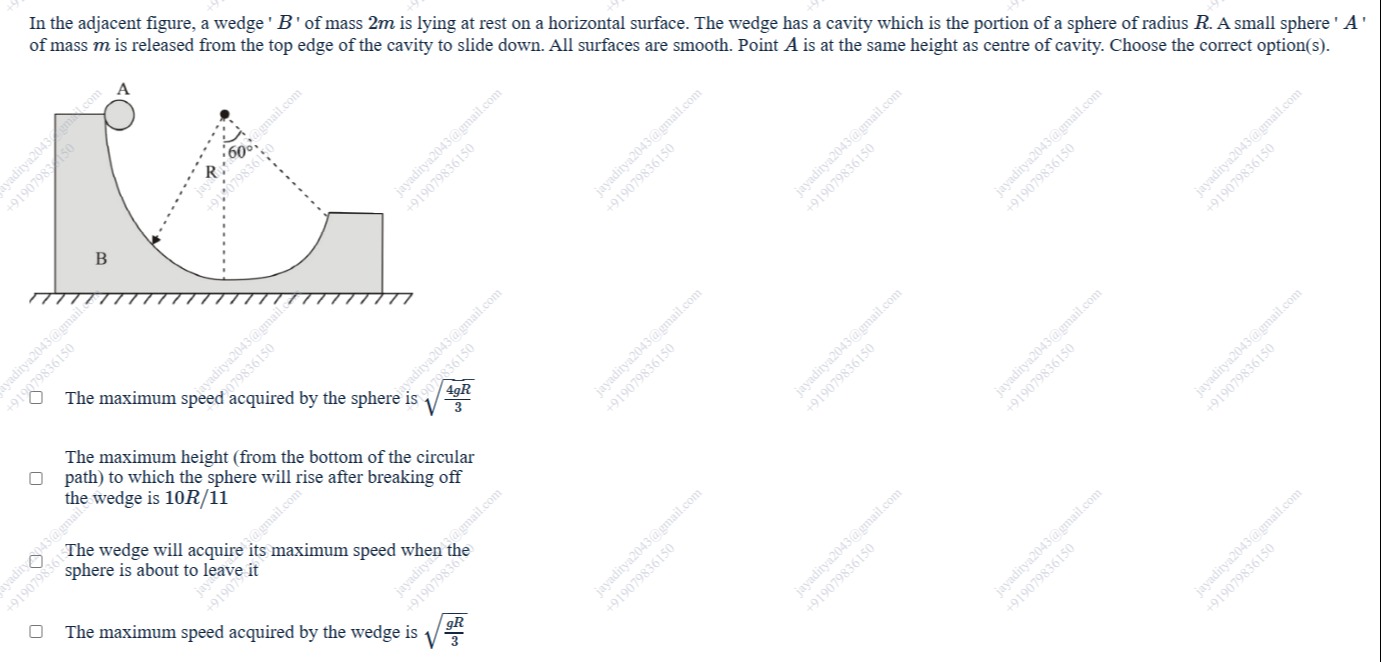Question
Question: In the adjacent figure, a wedge `B` of mass $2m$ is lying at rest on a horizontal surface. The wedge...
In the adjacent figure, a wedge B of mass 2m is lying at rest on a horizontal surface. The wedge has a cavity which is the portion of a sphere of radius R. A small sphere A of mass m is released from the top edge of the cavity to slide down. All surfaces are smooth. Point A is at the same height as centre of cavity. Choose the correct option(s).

The maximum speed acquired by the sphere is 34gR
The maximum height (from the bottom of the circular path) to which the sphere will rise after breaking off the wedge is 10R/11
The wedge will acquire its maximum speed when the sphere is about to leave it
The maximum speed acquired by the wedge is 3gR
Options (1), (3) and (4)
Solution
We will show that using energy–momentum conservation together with the condition for separation the correct choices come out to be options (1), (3) and (4).
A. Outline of the Reasoning
-
System and Conservation Laws
- The sphere (mass m) slides inside the spherical cavity (radius R) cut in a wedge (mass 2m) on a smooth horizontal surface.
- Since there is no external horizontal force the horizontal momentum of the (sphere + wedge) system is conserved; if the sphere’s horizontal component of velocity (in the ground frame) is ux and the wedge’s speed is V then mux+2mV=0⟹ux=−2V.
-
Energy Conservation
- Taking the drop in gravitational potential energy of the sphere (from its initial height) one obtains mgΔh=21mu2+21(2m)V2, where u is the speed of the sphere in the ground frame (which is related to its speed relative to the wedge plus the wedge speed).
-
Separation Condition
-
The sphere is in contact with the spherical cavity until the normal force vanishes. Writing the equation of motion in the (non‐inertial) frame of the wedge (which sees an effective acceleration having both the gravitational component and the wedge’s acceleration) one finds that at the instant of loss of contact the radial (centripetal) requirement becomes:
Rv2=Acosθ+gsinθ,where v is the sphere’s speed relative to the wedge, A the wedge’s acceleration, and θ the angle locating the sphere on the circular path. A careful analysis (with proper geometric relations and by differentiating the momentum constraint) ultimately yields the standard results:
-
The maximum speed (in the ground frame) attained by the sphere is
umax=34gR,which is option (1).
-
The wedge attains a maximum speed of
Vmax=3gR,which is option (4).
-
-
-
Timing of the Maximum Wedge Speed
- It turns out that the wedge’s speed increases monotonically so that when the sphere loses contact the wedge has already reached its maximum speed. This is exactly what option (3) asserts.
-
On Option (2)
- A similar analysis (tracking the energy conversion after separation) shows that the height reached by the sphere after leaving the wedge is not 10R/11. (A detailed calculation along the same lines used in the classic “wedge–block” problems will show the numerical value is different.)
B. Summary
- umax=34gR and Vmax=3gR. Also, the maximum wedge speed is reached just as the sphere loses contact. The proposed maximum height 10R/11 is not obtained.
